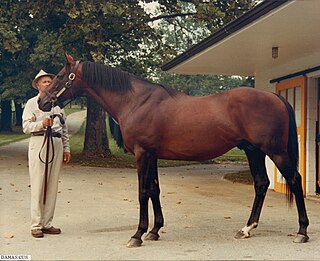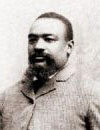
Georgetown is a home rule-class city in Scott County, Kentucky, United States. The population was 37,086 at the 2020 census. It is the 6th-largest city by population in the U.S. state of Kentucky. It is the seat of its county. It was originally called Lebanon when founded by Rev. Elijah Craig and was renamed in 1790 in honor of President George Washington. Historically, settlers were drawn to Georgetown for its Royal Spring.

The National Museum of Racing and Hall of Fame was founded in 1950 in Saratoga Springs, New York, to honor the achievements of American Thoroughbred race horses, jockeys, and trainers. In 1955, the museum moved to its current location on Union Avenue near Saratoga Race Course, at which time inductions into the hall of fame began. Each spring, following the tabulation of the final votes, the announcement of new inductees is made, usually during Kentucky Derby Week in early May. The actual inductions are held in mid-August during the Saratoga race meeting.

Harry Payne Whitney was an American businessman, thoroughbred horse breeder, and member of the prominent Whitney family.

Glencoe (1831–1857) was a British bred Thoroughbred racehorse, who won the 2,000 Guineas Stakes and the Ascot Gold Cup. He was one of the earliest Thoroughbred stallions imported into the United States and was a top broodmare sire there. Several outstanding sons of Lexington were out of Glencoe mares, including Asteroid, Kentucky and Norfolk.

Lexington was a United States Thoroughbred race horse who won six of his seven race starts. Perhaps his greatest fame, however, came as the most successful sire of the second half of the nineteenth century; he was the leading sire in North America 16 times, and broodmare sire of many notable racehorses.

Damascus was a champion American Thoroughbred racehorse who was the 1967 Horse of the Year after winning the Preakness Stakes, Belmont Stakes, Travers Stakes, Jockey Club Gold Cup, Woodward Stakes, and Dwyer Stakes. Damascus also came third in the Kentucky Derby that year.

Diomed (1777–1808) was an English Thoroughbred race horse who won the inaugural running of the Epsom Derby in 1780. Sold and imported to Virginia, he was subsequently a successful sire in the United States after the American Revolutionary War.

Woodburn Stud was an American horse breeding farm located in Woodford County, Kentucky about ten miles (16 km) from the city of Lexington. It was established in the 18th century as an original land grant property of General Hugh Mercer to whom it had been granted for his military services during the American Revolutionary War. Robert Alexander (1767–1841), a Scottish immigrant, came to Virginia from Scotland in 1786. Around 1790 he purchased the Mercer estate in Kentucky. Under the guidance of his son, Robert A. Alexander, during the 19th century, Woodburn Stud became the birthplace of Kentucky's Thoroughbred industry.

Edward Dudley Brown was an American who, although born as a slave, rose to become a Belmont Stakes-winning jockey, a Kentucky Derby-winning horse trainer, and an owner of several of the top racehorses during the last decade of the 19th century, earning him induction into the United States Racing Hall of Fame.

Joseph Early Widener was a wealthy American art collector who was a founding benefactor of the National Gallery of Art in Washington, D.C. A major figure in thoroughbred horse racing, he was head of New York's Belmont Park and builder of Miami's Hialeah Park racetrack in Florida.
Loyd "Boo" Gentry Jr. was an American horse trainer best known for training Proud Clarion to win the 1967 Kentucky Derby.
Edward Riley Bradley was an American steel mill laborer, gold miner, businessman and philanthropist. As well as a race track proprietor, he was the preeminent owner and breeder of Thoroughbred racehorses in the Southern United States during the first three decades of the 20th century. Testifying before a United States Senate committee in April 1934, Bradley identified himself as a "speculator, raiser of race horses and gambler". He appeared on the cover of Time magazine on May 7, 1934. In the year 2000, the Florida Department of State honored him as one of their Great Floridians.
Proud Clarion was an American Thoroughbred racehorse best known for winning the 1967 Kentucky Derby.
Elmendorf Farm is a Kentucky Thoroughbred horse farm in Fayette County, Kentucky, involved with horse racing since the 19th century. Once the North Elkhorn Farm, many owners and tenants have occupied the area, even during the American Civil War. Most of the land acquired during Haggin's era has since been sold off to neighboring stud farms, but the original 765 acres including the columns and many of the historic barns and houses still exist at Elmendorf.

Kingfisher (1867–1890) was an American Thoroughbred racehorse who won the 1870 Belmont Stakes.

Vagrant was an American Thoroughbred racehorse best known for his 1876 Kentucky Derby win. He was the first of nine geldings to win the Kentucky Derby and was a white-stockinged bay colt sired by Virgil out of the mare Lazy. Virgil was notable for siring successful nineteenth-century race horses and stood at Milton H. Sanford's Preakness Stud in Lexington, Kentucky. Through his sire, Vagrant is related to two other early Kentucky Derby winners, Hindoo (1881) and Ben Ali (1886).

John Edward Madden was a prominent American Thoroughbred and Standardbred owner, breeder and trainer in the late nineteenth and early twentieth century. He owned Hamburg Place Stud in Lexington, Kentucky and bred five Kentucky Derby and Belmont Stakes winners.

Luke McLuke was a bay Thoroughbred stallion born in the United States. He won the 1914 Belmont Stakes, the Carlton Stakes, Kentucky Handicap, and Grainger Memorial Handicap among his four wins from six starts. After his racing career was over, he became a breeding stallion, siring 11 stakes winners. Two of his daughters were named as year-end Champions in the United States.

Springbok (1870–1897) was an American Thoroughbred racehorse who won the seventh Belmont Stakes in 1873. Foaled in 1870, he was sired by the imported stallion Australian, his dam was a daughter of Lexington. During his racing career he started 25 races, winning 17 of them. Besides the Belmont, Springbok won the Saratoga Cup twice, in 1874 and 1875 and was named Champion Older Male horse in 1874 and 1875. After retiring from the racetrack, he sired five stakes winners and died in 1897.
Australian was a British-bred Thoroughbred racehorse and sire. He was exported to the United States where he had modest success as a racehorse but became a very successful and influential breeding stallion.
















